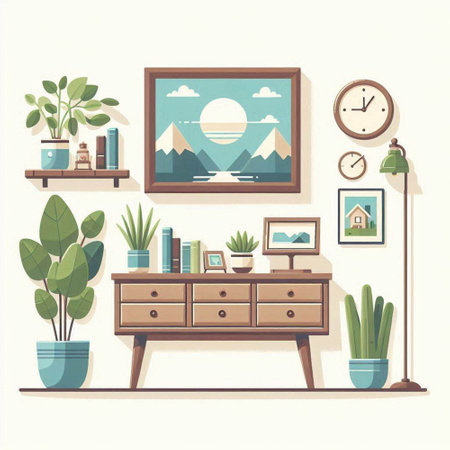Introduction: British Weather and Home DIY
Living in the UK means making peace with a climate that loves to keep us guessing. One day, we’re basking in a rare patch of sunlight; the next, we’re reaching for our wellies as the drizzle returns. This ever-changing weather doesn’t just dictate our wardrobe—it shapes the way we approach indoor painting and seasonal DIY projects, too. Whether you’re sprucing up a hallway or giving your living room a fresh lick of paint, understanding how British weather impacts our homes is key. It’s about more than just keeping dry; it’s about working with humidity, temperature shifts, and even those unexpected cold snaps. This unique climate nudges us to plan our projects with care, making sure that every brushstroke not only looks its best but stands the test of time (and rain clouds). In this article, we’ll explore why Britain’s four-seasons-in-a-day reputation matters when you’re planning your next indoor DIY adventure.
Light, Damp, and Temperature: Challenges Across the Seasons
When it comes to painting indoors in Britain, the weather outside has a surprising impact on your DIY success. The classic British climate is a mix of damp autumns, crisp winters, wet springs, and the odd burst of summer warmth. Each season presents its own set of hurdles for getting that perfect paint finish—whether you’re freshening up a lounge or giving kitchen cupboards a new lease of life.
Three main factors come into play: light, damp, and temperature. Here’s how each typically British season can affect your indoor painting projects:
| Season | Light | Dampness | Temperature | Effect on Painting |
|---|---|---|---|---|
| Autumn | Shorter days, less natural light | High humidity, frequent rain | Mild to cool | Slower drying times; risk of patchy finish due to moisture; need for good artificial lighting |
| Winter | Minimal daylight hours | Damp and condensation common indoors | Cold interiors unless heated | Paint may not cure properly; increased risk of streaks; ventilation can be tricky with closed windows |
| Spring | Brighter but still cool | Occasional showers and lingering dampness | Chilly mornings and evenings | Drying improves with more light; still need to watch out for cold snaps affecting finish quality |
| Summer | Longest days, plenty of sunlight | Drier air (except during heatwaves) | Warm temperatures indoors | Quicker drying times; best conditions for even coats; risk of paint drying too quickly if it gets too hot |
If you’re aiming for professional-looking results, timing your project with the seasons in mind is key. Autumn’s persistent damp may call for dehumidifiers and extra patience between coats. In winter, consider painting during midday when rooms are warmest and open windows briefly for ventilation without letting too much cold in. Spring brings optimism—and better daylight—but keep an eye on temperature dips. Summer offers the most forgiving conditions overall but don’t forget to ventilate well if heat builds up.

3. Spring Fresh: Embracing Longer Days for Renovation
There’s something uniquely uplifting about the arrival of spring in the UK. After months of short, grey days and damp weather, the first signs of sunshine and milder temperatures bring a renewed energy to our homes. It’s no wonder, then, that spring is widely regarded as the best time to start interior painting projects. With longer daylight hours and more consistent weather, homeowners can make the most of natural light, ensuring colours appear true and brushwork isn’t rushed by fading evening gloom. Unlike the unpredictable showers of winter or the stuffiness of high summer, spring offers just the right balance – open a window for ventilation without freezing, and let fresh air help your paint dry evenly. This season also tends to be less humid, meaning your walls will absorb paint better and dry with fewer streaks or bubbles. To fully utilise these advantages, plan ahead: clear your spaces, organise your supplies, and set up a practical work schedule that takes advantage of those bright mornings and lingering evenings. Whether you’re refreshing a tired hallway or giving your living room a completely new look, spring’s gentle climate means you can take your time – achieving a neat finish without feeling rushed. For many Brits, this period is not just about redecorating; it’s about embracing a sense of renewal throughout the home.
4. Autumn and Winter: Battling Moisture Indoors
As the British weather turns colder and wetter, indoor DIY painting projects come with a unique set of challenges. The rise in humidity, regular rainfall, and fluctuating indoor temperatures can impact both the quality and drying time of your paintwork. To keep your project on track and prevent common pitfalls like peeling or bubbling, it’s essential to understand how to manage these conditions effectively.
Tips for Managing High Humidity
Moisture from outside easily finds its way indoors during autumn and winter, especially in older British homes. High humidity can cause paint not to adhere properly or extend drying times significantly. Try these practical solutions:
| Problem | Solution |
|---|---|
| High Humidity | Use a dehumidifier before and after painting; open windows when possible for short bursts; choose quick-drying or moisture-resistant paints. |
| Condensation on Walls | Wipe surfaces dry before starting; avoid painting directly after heavy rainfall or on foggy days; heat the room gently to reduce condensation. |
Controlling Indoor Temperatures
Bitterly cold temperatures can make paint thicker and harder to spread evenly. On the other hand, overheated rooms may cause paint to dry too quickly, resulting in uneven finishes. Aim for a stable room temperature between 10°C and 20°C – this is the sweet spot for most paint products used across the UK.
Top Tips for Fluctuating Conditions
- Warm up your workspace slowly using central heating or portable radiators—avoid direct heat on painted surfaces.
- If you’re working in an unheated room (like a conservatory or loft), bring paint tins indoors overnight to prevent them from getting too cold.
- Always check the manufacturer’s recommendations printed on the tin – some paints are specially formulated for low-temperature application.
Keeping Your Project Organised
Colder months mean you might need longer intervals between coats, so plan ahead. Keep all tools, brushes, and rollers neatly stored in sealed containers or bags when not in use to protect them from dampness. Consider labelling your materials by date used, so you know which area needs another coat next. Staying organised helps ensure that no corner is missed and that every wall gets the attention it deserves despite unpredictable weather.
5. Practical Storage and Organisation for Seasonal Work
When tackling indoor painting projects in the UK, organising your supplies isn’t just about tidiness—it’s about adapting to our famously changeable weather and making the most of each season. With British weather dictating when it’s best to paint, clever storage solutions can keep your paints, brushes, and tools in top condition, ready for action whenever the forecast allows.
Storing Paints: Keep It Cool, Dry, and Safe
Paint longevity depends on proper storage. In winter, avoid freezing garages or sheds; instead, store tins indoors in a cupboard or utility room where temperatures remain stable. During warmer months, ensure your storage space is cool and out of direct sunlight—excessive heat can spoil paint quality. Always reseal tins tightly, wiping any drips from the rim before closing to prevent stuck lids. Labelling each tin with the date and room used also helps you keep track between seasons.
Brushes and Rollers: Ready for Next Time
After each painting session, clean brushes and rollers thoroughly with water (for water-based paints) or appropriate solvents (for oil-based). Hang them up or lay flat to dry fully before storing in an airtight container or zip bag. This stops bristles from splaying and prevents dust from settling on your next project. For ongoing seasonal work, wrap damp brushes in cling film or foil to keep them fresh overnight—ideal if you’re waiting out a rainy spell before finishing up.
Tools and Accessories: Smart Sorting
Keep all your decorating kit together by dedicating a sturdy box or portable caddy for smaller items like masking tape, scrapers, stirrers, and sandpaper. Stackable plastic drawers or labelled baskets work well for larger items. Store everything off the floor to avoid moisture damage—a common concern in British homes during damp months. Keeping tools organised not only saves time but also reduces frustration when you’re itching to get started as soon as the weather improves.
By aligning your storage habits with the British calendar and climate, you’ll find that every project runs more smoothly—and your materials last much longer. A bit of thoughtful organisation now means less hassle later, letting you focus on the joy of transforming your home whatever the season throws at you.
6. Conclusion: Making the Most of Every Season
Adapting your indoor DIY plans to the unique quirks of British weather is all about embracing flexibility and planning ahead. Whether you’re tackling a fresh coat of paint in winter’s crisp air or making the most of summer’s natural light, there’s always an opportunity to create a home that feels organised, welcoming, and truly yours. Remember, each season brings its own set of advantages—be it faster drying times in summer or cosier project days during winter storms.
Don’t be discouraged by rainy weekends or unexpected cold snaps; instead, use these moments as a chance to sort out your space, reorganise your supplies, or plan your next creative burst. The key is to stay practical and patient—work with the weather rather than against it. Invest in good ventilation for damp days, select paints suited to cooler conditions when necessary, and always keep an eye on the forecast before you start. With a bit of British resourcefulness and an organised approach, every season can become the perfect time for your next DIY adventure.

